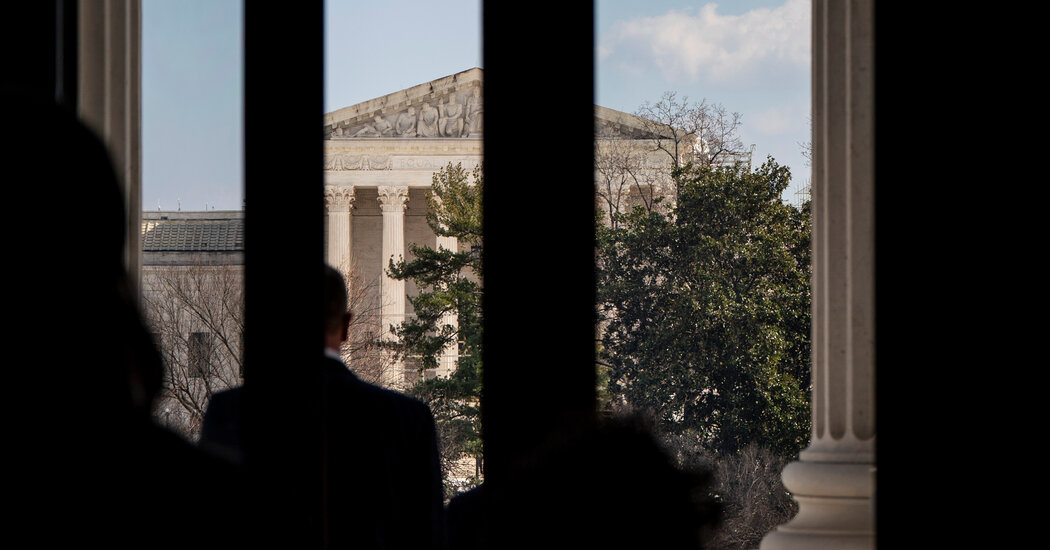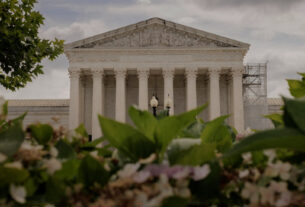There is no universally accepted definition of a constitutional crisis, but legal scholars agree about some of its characteristics. It is generally the product of presidential defiance of laws and judicial rulings. It is not binary: It is a slope, not a switch. It can be cumulative, and once one starts, it can get much worse.
It can also be obvious, said Erwin Chemerinsky, dean of the law school at the University of California, Berkeley.
“We are in the midst of a constitutional crisis right now,” he said on Friday. “There have been so many unconstitutional and illegal actions in the first 18 days of the Trump presidency. We never have seen anything like this.”
His ticked off examples of what he called President Trump’s lawless conduct: revoking birthright citizenship, freezing federal spending, shutting down an agency, removing leaders of other agencies, firing government employees subject to civil service protections and threatening to deport people based on their political views.
That is a partial list, Professor Chemerinsky said, and it grows by the day. “Systematic unconstitutional and illegal acts create a constitutional crisis,” he said.
The distinctive feature of the current situation, several legal scholars said, is its chaotic flood of activity that collectively amounts to a radically new conception of presidential power. But the volume and speed of those actions may overwhelm and thus thwart sober and measured judicial consideration.
It will take some time, though perhaps only weeks, for a challenge to one of Mr. Trump’s actions to reach the Supreme Court. So far he has not openly flouted lower court rulings temporarily halting some of his initiatives, and it remains to be seen whether he would defy a ruling against him by the justices.
“It’s an open question whether the administration will be as contemptuous of courts as it has been of Congress and the Constitution,” said Kate Shaw, a law professor at the University of Pennsylvania. “At least so far, it hasn’t been.”
Professor Shaw said a clash with the courts would only add to a crisis that is already underway. “A number of the new administration’s executive orders and other executive actions are in clear violation of laws enacted by Congress,” she said.
“The administration’s early moves,” she added, “also seem designed to demonstrate maximum contempt for core constitutional values — the separation of powers, the freedom of speech, equal justice under law.”
Pamela Karlan, a law professor at Stanford, added that a crisis need not arise from clashes between the branches of the federal government.
“It’s a constitutional crisis when the president of the United States doesn’t care what the Constitution says regardless whether Congress or the courts resist a particular unconstitutional action,” she said. “Up until now, while presidents might engage in particular acts that were unconstitutional, I never had the sense that there was a president for whom the Constitution was essentially meaningless.”
The courts, in any event, may not be inclined or equipped to push back. So much is happening, and so fast, that even eventual final rulings from the Supreme Court rejecting Mr. Trump’s arguments could come too late. After the U.S. Agency for International Development or the Consumer Financial Protection Bureau are disassembled, say, no court decision can recreate them.
In many cases, of course, the Supreme Court’s six-member conservative majority may be receptive to Mr. Trump’s arguments. Its decision in July granting him substantial immunity from prosecution embraced an expansive vision of the presidency that can only have emboldened him.
Members of that majority are, for instance, likely to embrace the president’s position that he is free to fire leaders of independent agencies.
The court may nonetheless issue an early, splashy ruling against Mr. Trump to send a signal about its power and independence. Striking down Mr. Trump’s order directing officials to deny citizenship to the children of immigrants would seem to be a good candidate, as it is at odds with the conventional understanding of the Constitution and the court’s precedents.
Such a decision would have an added benefit: It would be hard to disobey. From its earliest days, the Supreme Court has been wary of issuing rulings that might be ignored.
“I’m reminded of Marbury v. Madison, when the government did not even bother to show up before the Supreme Court to defend its position — strongly suggesting it would flout any court order against it,” said Amanda Frost, a law professor at the University of Virginia.
Even as the court ruled that the administration of Thomas Jefferson had acted unlawfully, she said, “the court carefully crafted its opinion in that case to avoid a ruling requiring executive branch compliance.”
Much has changed since that 1803 decision, and the Supreme Court’s stature and authority has grown. “Nonetheless,” Professor Frost said, “the Supreme Court may find it hard to defend the laws Congress enacted against executive usurpation when the Republican-controlled Congress refuses to do the same.”
Professor Karlan said she worried that the justices would rule for Mr. Trump for fear that he would ignore decisions rejecting his positions. “The idea that courts should preserve the illusion of power by abdicating their responsibilities would just make the constitutional crisis even worse,” she said.
Mr. Trump has already disregarded one Supreme Court decision, its ruling last month upholding a federal law, passed by lopsided bipartisan majorities, requiring TikTok to be sold or banned. Mr. Trump instead ordered the Justice Department not to enforce the law for 75 days, citing as authority for the move his “unique constitutional responsibility for the national security of the United States.”
Defiance of Supreme Court decisions is not unheard-of. Southern states, for instance, for years refused to follow Brown v. Board of Education, the 1954 decision that banned segregation in public schools, engaging in what came to be known as “massive resistance.”
The Brown decision is now almost universally viewed as a towering achievement. But its enforcement required President Dwight D. Eisenhower to decide to send members of the 101st Airborne Division to Little Rock, Ark., to escort Black students through an angry white mob.
Not all presidents gave the court’s rulings the same respect. In 1832, President Andrew Jackson refused to enforce a Supreme Court decision arising from a clash between Georgia and the Cherokee Nation. A probably apocryphal but nonetheless potent comment is often attributed to Jackson about Chief Justice John Marshall: “John Marshall has made his decision; now let him enforce it.”
Even before this weekend, Mr. Vance has said that Mr. Trump should ignore the Supreme Court. In a 2021 interview, he said Mr. Trump should “fire every single midlevel bureaucrat, every civil servant in the administrative state” and “replace them with our people.”
He added: “When the courts stop you, stand before the country like Andrew Jackson did and say, ‘The chief justice has made his ruling. Now let him enforce it.’”
Chief Justice John G. Roberts Jr. took note of such threats in his year-end report in December.
“Every administration suffers defeats in the court system — sometimes in cases with major ramifications for executive or legislative power or other consequential topics,” he wrote. “Nevertheless, for the past several decades, the decisions of the courts, popular or not, have been followed, and the nation has avoided the standoffs that plagued the 1950s and 1960s.”
“Within the past few years, however,” the chief justice went on, “elected officials from across the political spectrum have raised the specter of open disregard for federal court rulings. These dangerous suggestions, however sporadic, must be soundly rejected.”
That view has many supporters, though some use caveats. “It would be an extremely grave matter for a president to defy an actual (unstayed, in-effect) order of a federal court in a case that is indisputably in the court’s jurisdiction,” Ed Whelan, a conservative legal commentator, wrote on social media.
But considering discrete clashes may be relying on an outdated paradigm.
“One way to look at the administration’s assault on legal barriers is that it is seeking to establish ‘test cases’ to litigate and win favorable Supreme Court decisions,” Bob Bauer and Jack Goldsmith wrote in their Executive Functions newsletter. “But the typical test case is a carefully developed, discrete challenge to statutory or judge-made law with some good faith basis.”
Mr. Goldsmith is a law professor at Harvard and a former Justice Department official in the George W. Bush administration. Mr. Bauer was White House counsel for President Barack Obama. They are students of Article II of the Constitution, which sets out the powers of the president.
Mr. Trump’s executive orders have some features suggesting that they mean to test legal theories in the Supreme Court, they wrote. “But in the aggregate,” they added, “they seem more like pieces of a program, in the form of law defiance, for a mini-constitutional convention to ‘amend’ Article II across a broad front.”





